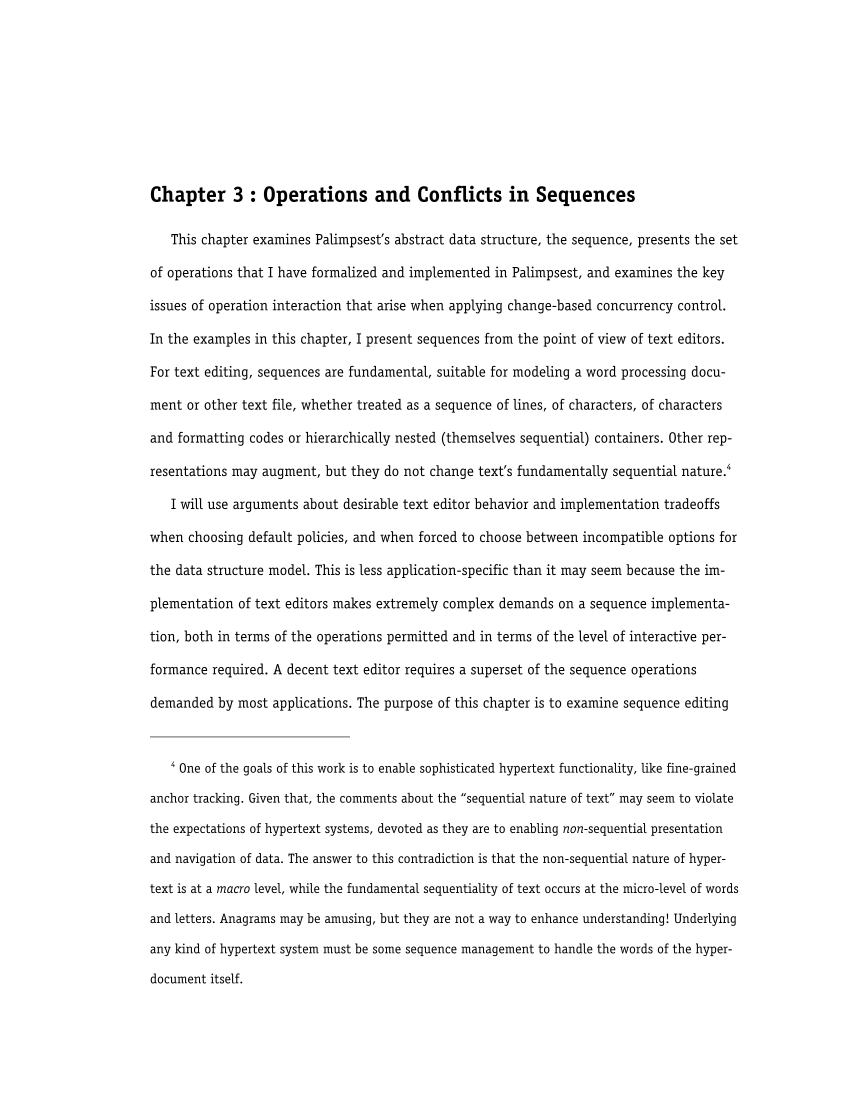Chapter�3: Operations�and�Conflicts�in�Sequences
This�chapter�examines�Palimpsest’s�abstract�data�structure,�the�sequence,�presents�the�set
of�operations�that�I�have�formalized�and�implemented�in�Palimpsest,�and�examines�the�key
issues�of�operation�interaction�that�arise�when�applying�change-based�concurrency�control.
In�the�examples�in�this�chapter,�I�present�sequences�from�the�point�of�view�of�text�editors.
For�text�editing,�sequences�are�fundamental,�suitable�for�modeling�a�word�processing�docu-
ment�or�other�text�file,�whether�treated�as�a�sequence�of�lines,�of�characters,�of�characters
and�formatting�codes�or�hierarchically�nested�(themselves�sequential)�containers.�Other�rep-
resentations�may�augment,�but�they�do�not�change�text’s�fundamentally�sequential�nature.
4
I�will�use�arguments�about�desirable�text�editor�behavior�and�implementation�tradeoffs
when�choosing�default�policies,�and�when�forced�to�choose�between�incompatible�options�for
the�data�structure�model.�This�is�less�application-specific�than�it�may�seem�because�the�im-
plementation�of�text�editors�makes�extremely�complex�demands�on�a�sequence�implementa-
tion,�both�in�terms�of�the�operations�permitted�and�in�terms�of�the�level�of�interactive�per-
formance�required.�A�decent�text�editor�requires�a�superset�of�the�sequence�operations
demanded�by�most�applications.�The�purpose�of�this�chapter�is�to�examine�sequence�editing
4
One�of�the�goals�of�this�work�is�to�enable�sophisticated�hypertext�functionality,�like�fine-grained
anchor�tracking.�Given�that,�the�comments�about�the�“sequential�nature�of�text”�may�seem�to�violate
the�expectations�of�hypertext�systems,�devoted�as�they�are�to�enabling�non-sequential�presentation
and�navigation�of�data.�The�answer�to�this�contradiction�is�that�the�non-sequential�nature�of�hyper-
text�is�at�a�macrolevel,�while�the�fundamental�sequentiality�of�text�occurs�at�the�micro-level�of�words
and�letters.�Anagrams�may�be�amusing,�but�they�are�not�a�way�to�enhance�understanding!�Underlying
any�kind�of�hypertext�system�must�be�some�sequence�management�to�handle�the�words�of�the�hyper-
document�itself.
This�chapter�examines�Palimpsest’s�abstract�data�structure,�the�sequence,�presents�the�set
of�operations�that�I�have�formalized�and�implemented�in�Palimpsest,�and�examines�the�key
issues�of�operation�interaction�that�arise�when�applying�change-based�concurrency�control.
In�the�examples�in�this�chapter,�I�present�sequences�from�the�point�of�view�of�text�editors.
For�text�editing,�sequences�are�fundamental,�suitable�for�modeling�a�word�processing�docu-
ment�or�other�text�file,�whether�treated�as�a�sequence�of�lines,�of�characters,�of�characters
and�formatting�codes�or�hierarchically�nested�(themselves�sequential)�containers.�Other�rep-
resentations�may�augment,�but�they�do�not�change�text’s�fundamentally�sequential�nature.
4
I�will�use�arguments�about�desirable�text�editor�behavior�and�implementation�tradeoffs
when�choosing�default�policies,�and�when�forced�to�choose�between�incompatible�options�for
the�data�structure�model.�This�is�less�application-specific�than�it�may�seem�because�the�im-
plementation�of�text�editors�makes�extremely�complex�demands�on�a�sequence�implementa-
tion,�both�in�terms�of�the�operations�permitted�and�in�terms�of�the�level�of�interactive�per-
formance�required.�A�decent�text�editor�requires�a�superset�of�the�sequence�operations
demanded�by�most�applications.�The�purpose�of�this�chapter�is�to�examine�sequence�editing
4
One�of�the�goals�of�this�work�is�to�enable�sophisticated�hypertext�functionality,�like�fine-grained
anchor�tracking.�Given�that,�the�comments�about�the�“sequential�nature�of�text”�may�seem�to�violate
the�expectations�of�hypertext�systems,�devoted�as�they�are�to�enabling�non-sequential�presentation
and�navigation�of�data.�The�answer�to�this�contradiction�is�that�the�non-sequential�nature�of�hyper-
text�is�at�a�macrolevel,�while�the�fundamental�sequentiality�of�text�occurs�at�the�micro-level�of�words
and�letters.�Anagrams�may�be�amusing,�but�they�are�not�a�way�to�enhance�understanding!�Underlying
any�kind�of�hypertext�system�must�be�some�sequence�management�to�handle�the�words�of�the�hyper-
document�itself.





























































































































































































